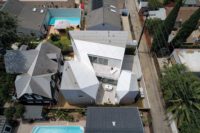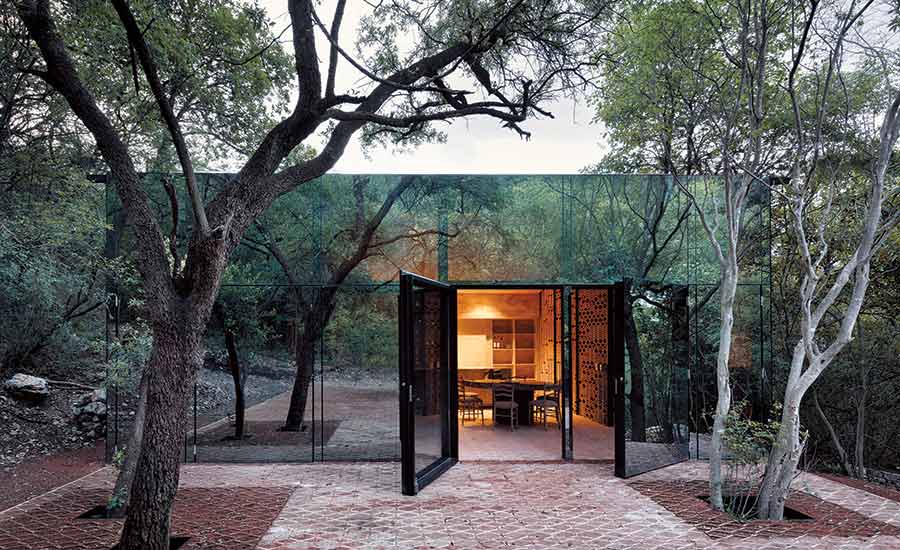Los Terrenos by Tatiana Bilbao
Monterrey, Mexico

The peak-roofed living pavilion is clad in mirrored glass.
Photo © Rory Gardiner

Inside, an open arrangement of V-shaped clay brick forms a playful screen.
Photo © Rory Gardiner

The swing doors open completely to the courtyard.
Photo © Rory Gardiner

The L-shaped sleeping quarters contain two stepped bedrooms facing in opposite directions.
Photo © Rory Gardiner

Simple materials like clay brick, rammed earth, and plywood mark the spare interiors.
Photo © Rory Gardiner

Simple materials like clay brick, rammed earth, and plywood mark the spare interiors.
Photo © Rory Gardiner

Image courtesy Tatiana Bilbao







Architects & Firms
In the 13 years since she established her studio in Mexico City, the architect Tatiana Bilbao has designed a body of work that is refreshingly dogma-free; she has never had a signature style. Instead, Bilbao’s varied projects in her native country—including an art-filled botanical garden; the master plan and open-air chapel for a pilgrimage route in the Jalisco Mountains; a research building that is a stack of glass boxes; and sustainable affordable housing—demonstrate an abiding interest in how people really use architecture. “Every building is different for us,” Bilbao says. “We try to think on a human scale.”
A case in point is a vacation house that Bilbao designed for a wooded site on a mountainside overlooking the city of Monterrey. The client, who lives in Mexico City, is the daughter of a couple who purchased the large tract and divided it into 60 lots for their heirs, who can build houses there on the condition that they hire architects to design them. So far, the roster includes Tadao Ando, the late Ricardo Legorreta, and contemporary Mexican architects like Alberto Kalach and Bernardo Gómez-Pimienta, as well as Bilbao herself, who had already designed a house—Casa Ventura, a series of pentagonal forms stepping down the hillside—nearby.
Additional Content:
Jump to credits & specifications
Bilbao conceived the new house, Los Terrenos (The Terrains), as a trio of small buildings (just under 2,200 square feet in total), each of which serves a specific function and emphasizes one of the three main materials in the project’s palette. The largest of these, a structure that contains an open living/dining/ kitchen space, is clad in mirrored glass, allowing it to disappear into the surrounding vegetation; its peak-roofed profile mirrors those of the mountains, and concealed doors open the interior to the terrace beyond.
Diagonally opposite, an L-shaped building with walls of clay brick and rammed earth houses two bedrooms and bathrooms. (A third structure, still unbuilt, will be made of wood and elevated for a view of the treetops.)
Using just three materials might seem downright monastic to many, but it was a cornucopia to Bilbao. “We usually use just one material,” she explains, alluding to the strict budgets of many of her projects. “We typically don’t get to do that much experimentation.” Still, she and her colleagues made a little go a long way. The mirrored-glass exterior of the living structure not only reflects the surrounding woods when you’re outside, but it also creates what Bilbao calls an “outside reflection” of the interior—a mirror image of the space that you can see outside the building when you’re sitting in it. The chevron-shaped clay-brick walls of the bedroom building reflect Bilbao’s idea that where you sleep should feel enclosed rather than exposed. But the architects use the basic form of the brick as a flexible language that also translates into the floors and the openwork screens in the living structure. Materials are used to sensual, elegant effect in both buildings, but are never precious; the smaller windows in the bedrooms, for instance, have shutters made of plywood.
Bilbao’s current projects include a social housing project in Lyon, France, that is made up of three completely different buildings; an art center in an abandoned church near Avila, Spain; four projects in the U.S. (none of which Bilbao can discuss); and 10 in Mexico, including a university building in Monterrey, a hotel in Los Cabos, and more low-cost housing, which represents half the office’s work these days. Many of these projects rely on local architects, builders and craftspeople, and Bilbao insists that clients be closely involved in the process. She recalls one client who commissioned a house, and then sent Bilbao a contract, saying, “See you in eight months—you can do what you want.” Bilbao refused, saying she would only design the house if the client showed up for meetings each week. “We don’t build for people,” she explains. “We build with people.”
CreditsArchitect: Tatiana Bilbao Estudio
Personnel in architect's firm who should receive special credit: Tatiana Bilbao
Engineers Paralelo Estándares Globales
General contractor: Paralelo Estándares Globales
Photographer: Rory Gardiner |
SpecificationsStructural System Steel frame for the social volume.
Exterior Cladding Masonry: The masonry tile was an element which was integral to the project. A clay unit (in the shave of a Chevron with outward facing tips) was incorporated into many elements of the house. For example, the paths around the compound use this element as a paver. In the social volume of the compound these were mounted with different orientations screen partitions that let in light. Each piece contains a hole where a steel bar runs through and secures the unit together. In the residential module masonry tile element was filled with a mixture of cement and mortar to match the colors of the element and infill. Wood: Woodwork is internal
Glazing Glass: Reflective glass was used to cover the facade of the public/communal volume. Skylights: Skilights were used in both buildings.
Doors Entrances: In the public volume doors are seamlessly integrated with the rest of the facade, using the same, reflective glass paneling. Sliding doors: In the private volume a collapsible partition system was employed which allows the rooms to be constantly connected to their beautiful natural environment.
Interior Finishes Demountable partitions: The masonry element was threaded through steel bars (like the construction employed for the private volume but without a mortar infill) creating semi-permeable screens that let light in but still demarcated space. Cabinetwork and custom woodwork: The woodwork in the house is pine and was obtained from local providers. Paneling: The woodwork in the house is pine and was obtained from local providers. And local carpenters worked the material into the various panels, cabinets, etc. Floor and wall tile: The floor tile is the same masonry element used throughout the rest of the project.
Furnishings Chairs: The furniture was selected by the client with the help of Tatiana Bilbao Estudio. Tables: The furniture was selected by the client with the help of Tatiana Bilbao Estudio. Upholstery: The furniture was selected by the client with the help of Tatiana Bilbao Estudio.
Energy Other unique products that contribute to sustainability: For the construction of exterior and terrace zones, the house respected the existing trees and opted to carve out space for them rather than cut these down. Tree roots are allowed to grow unscathed because the clay-tile masonry element was placed atop a platform and in a configuration that allows water to seep through. Add any additional building components or special equipment that made a significant contribution to this project: This house seeks to reevaluate the concept of living in nature. It poses that through a separations of a typical house program new dynamics of privacy, public gatherings, and harmony with the surrounding landscape can be achieved.
|











